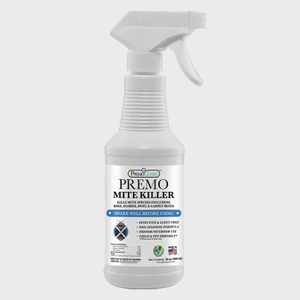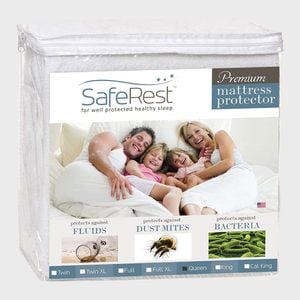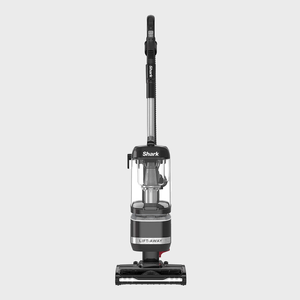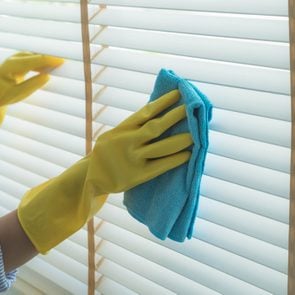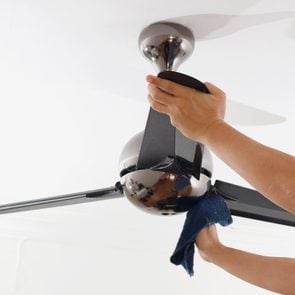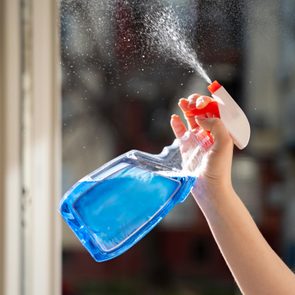How to Get Rid of Dust Mites for an Allergen-Free Home
Updated: May 04, 2023

Where do these unwanted pests come from? Learn quick and easy ways to get rid of dust mites in your home.
Dust mites are unwelcome guests for anyone, but they are particularly brutal for people with allergies. Fortunately, there are plenty of tips for how to get rid of dust mites. A few household changes and sticking to a cleaning schedule can help you get a handle on the problem right away. And if you’re prone to sneezing, here are the best cleaning products for people with allergies.
Taking simple steps to help eliminate these pesky creatures can drastically improve your allergy symptoms. “While dust mites themselves are not harmful to most people, their feces can trigger allergic reactions in those who suffer from allergies and asthma,” says Martin Seeley, CEO and sleep expert at MattressNextDay. “This includes respiratory problems and skin irritation, and in a worst-case scenario, they can even compromise a person’s immune system.”
Learning how to get rid of dust itself or how to clean carpet spills requires some expert know-how too. We gathered the best advice on how to get rid of dust mites. And if you want a cleaner and healthier home overall, add these professional suggestions to your spring cleaning list so you won’t make any more cleaning mistakes while you’re ridding your home of dust mites.
Get Reader’s Digest’s Read Up newsletter for more cleaning, humor, travel, tech and fun facts all week long.
What are dust mites?
Invisible to the naked eye, dust mites are microscopic creatures that thrive in warm and humid environments. According to Lauren Doss, owner of Nashville Maids, “dust mites appear in many homes, especially where there is high humidity and lots of dust.” In other words, basically everyone has at least some dust mites in their home—particularly since dust mites consume dust and dead skin flakes (shed by people and their pets).
What do dust mites look like?
You can’t see dust mites without a microscope. But if you could see them (or conveniently have a microscope on hand), they are oval and have eight legs. “They are translucent and have a white or cream color, which also makes them difficult to see against a light background,” Seeley points out.
Where do dust mites come from?
Dust mites get into the house in a variety of ways. “This includes through ventilation systems, on clothes or furniture, or even on pets,” Doss says. “They thrive in warm and humid environments, so it is important to keep your home dry and dust-free to reduce their presence.”
How do I know if I have dust mites?
One sign of dust mites could simply be your body’s reaction to them in the form of allergy symptoms. “Symptoms that readers should look out for include sneezing, coughing, runny nose, itchy and watery eyes and difficulty breathing,” says Doss. “Dust mites are allergens because they produce proteins in their droppings and bodies, which can cause an allergic reaction when inhaled.” As you begin to react to these allergens, your body releases histamine, a chemical that leads to allergic symptoms such as itching and sneezing.
However, another sign of dust mites is the presence of dust itself. “Visible signs of dust mite infestation include dust buildup on surfaces, particularly in areas where people spend a lot of time, such as beds and sofas,” says Zak Fleming, owner of Express Handyman. Hence, it’s important to make sure you know how to clean a mattress or how to clean a couch.
How to get rid of dust mites?
Despite their size, dust mites can inhabit nearly every surface where people tend to spend a lot of time. Beds and mattresses—plus carpets and upholstered furniture—are just some of the usual suspects hosting dust mites. Here’s what to do about it.
Vacuum regularly
Many people might not know that dust mites come into the home on clothing or shoes. So vacuuming the floors where dust mites can congregate is a great place to start. “Vacuum carpets and upholstered furniture at least once a week,” says Fleming. This will prevent the buildup of both dust and dust mites inside your home. “But be sure to use a vacuum with a HEPA filter,” he adds.
HEPA stands for “high-efficiency particulate air,” and a vacuum with a HEPA filter can trap many very small particles better than other vacuums. “You should also remember to vacuum under your bed, as this is another dust-mite hotspot,” says Seeley. If you’re in the market for a new floor sweeper, try one of these dependable vacuum cleaners.
Wash your bedding
Dust mites consume dust, much of which contains human skin. So what better place for the dust mites to hang out than between the sheets? Fleming suggests washing bed sheets in hot water at 130 degrees once a week to ensure you’ve removed all dust mites from the bed’s surface. To be extra careful, also dry your bedding on high heat (always check your sheets special care instructions). All this extra heat will kill the dust mites. While you’re at it, consider cleaning other cloth you regularly come into contact with, like bath towels.
Reduce humidity
Because dust mites thrive in high humidity, make your home a less tempting environment for them by decreasing your humidity levels. Doss recommends keeping it between 35% and 50%. Chris Matthias, founder of House Adorable, recommends using a dehumidifier, as this device will remove moisture from the air. “It is nearly impossible to completely eliminate dust mites, as they are a natural part of our environment,” he says.
Protect mattresses and pillows
“Using dust mite covers on mattresses and pillows creates a barrier between the dust mites and the person sleeping on the bed, reducing allergen exposure,” says Fleming. Keeping a barrier between skin and potential dust mites will help keep those with allergies unaffected by the dust mites. Opt for hypoallergenic covers or a mattress protector.
Reconsider your carpeting
Instead, choose hardwood or tile floors. While “vacuuming helps to remove dust mites from carpets,” Doss says harder floors are better. With all their porous surfaces, carpets can house dust mites quite easily. “So avoid carpets and rugs if possible,” she says. Not to mention, it can be much easier to clean hardwood floors.
Get rid of clutter
Since dust accumulates in even the oddest of crevices, it’s wise to reduce dust-collecting clutter. “Limit the amount of clutter and dust collectors in your home, such as books, magazines and stuffed animals,” says Doss. And once you’ve gotten rid of the extra stuff, make sure to clean all those nooks and crannies you’ve uncovered.
Lower room temperatures
While not always ideal for people who tend to feel cold, retaining a cool temperature—less than 68 degrees—in your home will keep dust mites from multiplying. Keeping the environment unwelcome helps keep their numbers low enough that they can’t spread, says Matthias.
Supplies that help you get rid of dust mites
Sources:
- Martin Seeley, CEO and sleep expert at MattressNextDay
- Lauren Doss, owner of Nashville Maids
- Zak Fleming, owner of Express Handyman
- Chris Matthias, founder of House Adorable





















